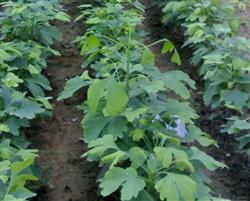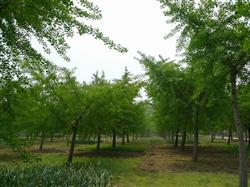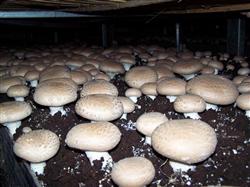Seedling raising technique of hardwood cutting of Ginkgo biloba

The common seedling raising methods of Ginkgo biloba are sowing, cutting, root tillering and grafting, etc. Cutting seedlings of Ginkgo biloba can not only save seeds and reduce seedling costs, but also speed up seedling breeding and maintain the excellent characteristics of varieties. Hardwood cutting is a method of raising seedlings with more than one-year-old branches with a high degree of Lignification, and the routine management after hardwood cutting is much easier than that of tender wood cuttings. In order to do a good job of ginkgo hardwood cutting seedlings, we should mainly grasp the following links: first, the preparation of the substrate: the commonly used substrates for hardwood cutting are river sand, sandy loam, sandy soil and so on. The rooting rate of sandy loam and sandy soil is low, which is mostly used for large area cutting in spring; the rooting rate of river sand is high, and the material is easy to be obtained, so it is widely used in cutting seedlings. Second, the preparation for inserting the bed: the bed is 20 meters long and 1.2 meters wide, and the bed is covered with a layer of fine river sand with a thickness of about 20 centimeters. The week before insertion, it is sterilized with 0.3% potassium permanganate solution, and 10 kg solution per square meter is used alternately with 0.3% formaldehyde solution. Cover it with plastic film after spraying, rinse it with clean water for 3 times after two days, and then cuttage. Third, collecting panicles: after defoliation in late autumn and early winter, and one week before cutting or combined with pruning in spring, the branches are required to be pest-free, robust and full of buds. Generally, 1-3-year-old branches from young trees under 20 years old are selected as spikes. According to the experiment, the rooting rate of 1-year-old branches is the highest, up to 93%. The longer the branch age, the lower the rooting rate, and the rooting rate of the branches of the real trees was higher than that of the grafted branches. Fourth, the treatment of cuttings: cut the branches into 15ml 20cm long, containing more than 3 full buds, the upper end of the cuttings is flat, and the lower end is oblique. Pay attention to the direction of the bud is not reversed, every 50 branches of a bundle, the lower end of alignment, soak in 100ppm's naphthalene acetic acid solution for 1 hour, the lower end immersed in 5Mel 7cm. The branches picked in autumn and winter are tied up in bundles for sand storage to survive the winter. Fifth, cutting: conventional cutting is mainly in spring, usually in the middle and late March, and can be cut early in spring in the plastic greenhouse. When cutting, the cuttings were first trenched, and then inserted into the cuttings. Two buds were exposed on the ground, covered with soil, and the row spacing was 10 × 30 cm. Spray water after insertion to make cuttings in close contact with sand. The humidity is controlled at 85 per cent. 6, management: 1, shading: black shading net or artificial shed can be used to shade, conditional plastic greenhouse is better, so that the nursery to maintain a cool, moist microclimate. 2. Water spraying: open-field cuttings should be sprayed once in the morning and evening on a continuous sunny day, in addition to irrigation immediately after cutting, and gradually reduce the number of times and amount of water spraying after 1 month. 3. Topdressing: after cuttings took root from May to June, 0.1% urea and 0.2% potassium dihydrogen phosphate solution were used for foliar spraying, twice a month. 4. Transplanting: cuttings in the open field shall be removed directly after defoliation and before sprouting in the following year; cuttings in greenhouse should be refined before transplanting. 5. Control of diseases and insect pests: the main diseases and insect pests in the cutting nursery of Ginkgo biloba are underground pests, leaf-eating pests and stem rot. 1000 times of methyl isofloxate can be used to infuse the roots of seedlings in the afternoon, killing more than 90% of ground tigers, and can also control grubs and golden needle worms. 0.2% carbofuran mixed with water or 2.5% enemy kill 2000 times solution can also be sprayed all over the ground to control underground pests; 2.5% enemy kill 3000 times solution or 40% omethoate EC 500x solution can be used to control leaf-eating pests; 5% ferrous sulfate solution can be sprayed every 20 days since June, and fungicides such as carbendazim and Bordeaux solution can be sprayed to prevent stem rot.
- Prev

Five main aspects of management of ginkgo biloba
Ginkgo biloba, also known as ginkgo, is one of the rare and precious fruit trees. Its species, leaves and preparations are widely used. The key points of relevant cultivation techniques are introduced as follows: ginkgo, also known as ginkgo, is one of the rare and precious fruit trees, its species, leaves and preparations have a wide range of uses. Now the key points of relevant cultivation techniques are introduced as follows: one.
- Next

Control of mushroom brown spot
The rare mushroom-brown mushroom, also known as mushroom, its cover is thick, the meat is thick, the taste is more delicate and delicious than white mushroom, the flavor is more rich and palatable than Lentinus edodes, and it has high nutrition and health care value at the same time. Has become popular in Europe and the United States and the world's developed countries or regions of high-grade edible fungi, and formed its.
Related
- Fuxing push coffee new agricultural production and marketing class: lack of small-scale processing plants
- Jujube rice field leisure farm deep ploughing Yilan for five years to create a space for organic food and play
- Nongyu Farm-A trial of organic papaya for brave women with advanced technology
- Four points for attention in the prevention and control of diseases and insect pests of edible fungi
- How to add nutrient solution to Edible Fungi
- Is there any good way to control edible fungus mites?
- Open Inoculation Technology of Edible Fungi
- Is there any clever way to use fertilizer for edible fungus in winter?
- What agents are used to kill the pathogens of edible fungi in the mushroom shed?
- Rapid drying of Edible Fungi

